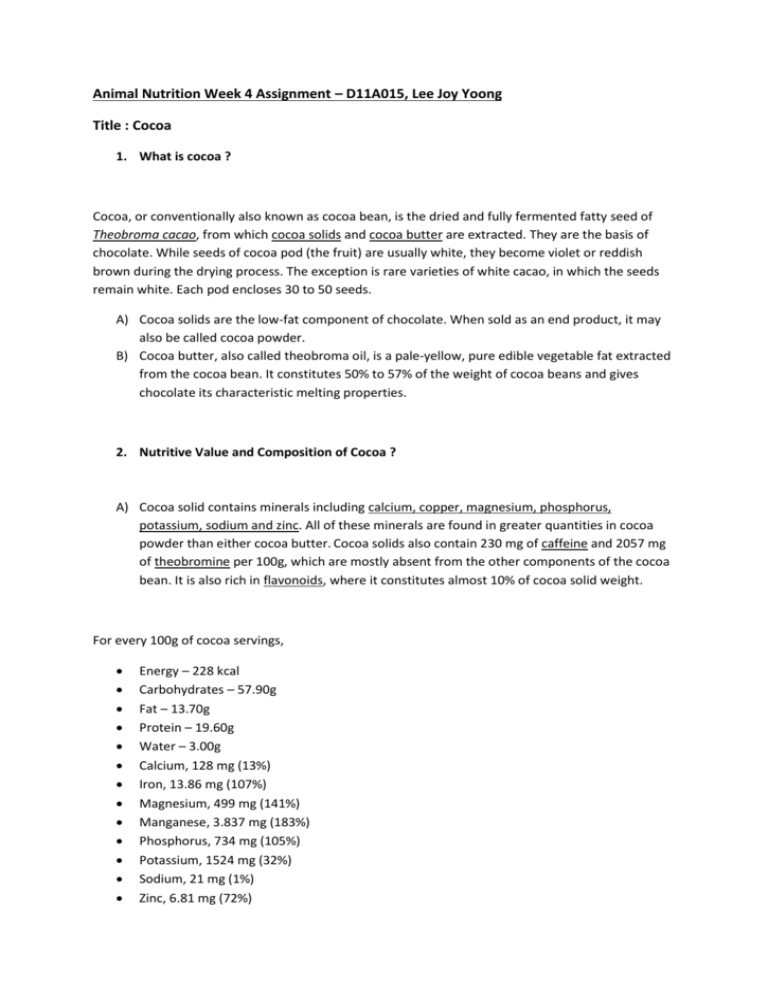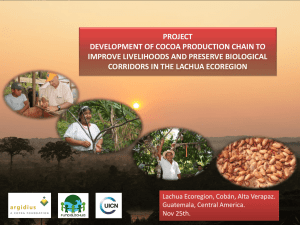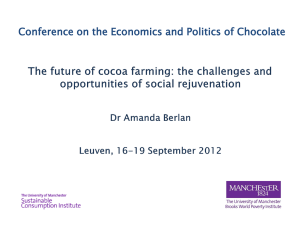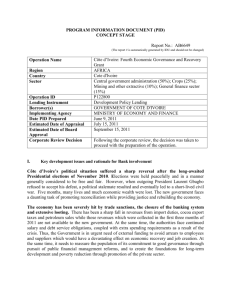Cocoa (Joy) - UMK CARNIVORES 3
advertisement

Animal Nutrition Week 4 Assignment – D11A015, Lee Joy Yoong Title : Cocoa 1. What is cocoa ? Cocoa, or conventionally also known as cocoa bean, is the dried and fully fermented fatty seed of Theobroma cacao, from which cocoa solids and cocoa butter are extracted. They are the basis of chocolate. While seeds of cocoa pod (the fruit) are usually white, they become violet or reddish brown during the drying process. The exception is rare varieties of white cacao, in which the seeds remain white. Each pod encloses 30 to 50 seeds. A) Cocoa solids are the low-fat component of chocolate. When sold as an end product, it may also be called cocoa powder. B) Cocoa butter, also called theobroma oil, is a pale-yellow, pure edible vegetable fat extracted from the cocoa bean. It constitutes 50% to 57% of the weight of cocoa beans and gives chocolate its characteristic melting properties. 2. Nutritive Value and Composition of Cocoa ? A) Cocoa solid contains minerals including calcium, copper, magnesium, phosphorus, potassium, sodium and zinc. All of these minerals are found in greater quantities in cocoa powder than either cocoa butter. Cocoa solids also contain 230 mg of caffeine and 2057 mg of theobromine per 100g, which are mostly absent from the other components of the cocoa bean. It is also rich in flavonoids, where it constitutes almost 10% of cocoa solid weight. For every 100g of cocoa servings, Energy – 228 kcal Carbohydrates – 57.90g Fat – 13.70g Protein – 19.60g Water – 3.00g Calcium, 128 mg (13%) Iron, 13.86 mg (107%) Magnesium, 499 mg (141%) Manganese, 3.837 mg (183%) Phosphorus, 734 mg (105%) Potassium, 1524 mg (32%) Sodium, 21 mg (1%) Zinc, 6.81 mg (72%) *** Flavonols, a type of flavonoids in cocoa solid, had been suggested benefiting patients with coronary heart disease and stroke. (Involved in NO metabolism) ***Cocoa with a pH of 5.4-5.8 is considered natural powders and has a light brown colour. Lightly alkalized cocoa solids have a pH of 6.8-7.2 and are a darker brown colour. Moderately alkalized cocoa solids have a pH of 7.2-7.5 and have a deep reddish brown colour, and heavily alkalized powders with a pH of 7.5-8.1 have dark red and black colours. (Light brown Dark brown Reddish brown Dark red and black) B) Cocoa butter has a high content of saturated fats derived from stearic and palmitic acids. Cocoa butter, unlike cocoa solids, has no more than trace amounts of caffeine and theobromine. Cocoa butter is one of the most stable fats known, a quality that coupled with natural antioxidants (Vitamin C and E) that prevent rancidity. For every 100g of cocoa butter i. ii. iii. iv. v. i. ii. iii. iv. Energy – 900 kcal Saturated Fats (57 – 64%) Stearic acid (24-37%) Capric acid (0-10%) Myristic acid, (0-4%) Arachidic acid (1%) Lauric acid (0-1%) Unsaturated Fats (36 – 43%) Linoleic acid (1-4%) Linolenic acid (0-1%) Oleic acid (29-38%) Palmitoleic acid (35–41%) 3. Role of cocoa in animal diet. Cocoa contains a high level of specifically theobromine that is detrimental to the health of many animals including dogs and cats. They cannot be efficiently metabolized in many animals and can lead to cardiac and nervous system problems, and if consumed in high quantities, even lead to death. However, since the beginning of the 21st century, some cocoa derivatives with a low concentration of xanthenes (theobromine and caffeine) have been designed by animal food industry. It results in products with a high concentration of fiber and proteins, while maintaining low concentrations of sugar and other carbohydrates, thus enabling it to be used to create healthy functional cocoa feed. Cocoa solids too give rise to rich content of minerals while cocoa butter give rise to high content of antioxidants to the animals Though, conventionally in developing countries, cocoa pods are used for feeding purposes, in European countries, discarded confectionary (made of cocoa solids (powdered)), cocoa bean meal had been practised. If theobromine is not properly removed from cocoa meals, (especially cocoa seeds) or in other words fed to animals, it will give different effects to animals, depending on species and breeds. Cattle: General health was good, milk yields normal, increased butter fat yield and stiffened stools but decreased milk yield. Goat: Reduced voluntary dry matter intake, leading to reduced body weight gain. Sheep : Low level stimulate feed intake and growth, while high level cause depression to feed intake and weight gain Horses : Anorexia, diarrhoea, increased pulse rate with no significant changes in temperature and respiratory rate beyond tolerance range Pig : Pneumonic lesions, excessive pericardial fluid, congested liver, stomach and small intestine inflammation beyond tolerance range Carnivores : Tremors, seizures, coma, excitements, cardiac stimulation, panting, vomiting, thirst, diarrhoea, incontinence, and sudden death However, different cocoa feeds are available to animal feeds. 4. How it is processed? I. II. Cocoa bean meal is rarely given as feed to animal because it is sold for livestock feeding when excess cocoa is produced, as surpluses. It is prepared from discarded cocoa beans, press cake of cocoa beans or residues of cocoa factories. The only drawback of it is the high content of theobromine. Water treatments of above 60 degree Celsius for hours (extraction of theobromine) make it a good grower fattener ration for swine. Cocoa bean shell – After the beans had been removed from the pods, the pods (usually with fruits flesh dried and fermented. The fibrous materials that consist mainly of seed coat and embryo (cocoa shell) is roasted to separate the cotyledons out. The shell is now dry, crisp, and slightly brown husk of chocolate odour. Cocoa shell has a high fibre content and thus recommendable for ruminant feeding. 5. Inclusion level of cocoa in animals. (In terms of tolerance range of theobromine) Summary Cattle : 14 – 45 mg / kg body weight Goat : 290 – 420 mg / kg body weight Sheep : 30 – 40 mg / kg body weight Horses : 0.5 – 2 mg / kg body weight Pig : 7 – 14 mg / kg body weight Broiler chicken : 26 – 110 mg / kg body weight Layer hen : 66 mg / kg body weight Carnivores : < 20 mg / kg body weight References: a) b) c) d) e) f) http://en.wikipedia.org/wiki/Cocoa_bean http://en.wikipedia.org/wiki/Cocoa_solids http://en.wikipedia.org/wiki/Cocoa_butter http://en.wikipedia.org/wiki/Chocolate#Production http://www.faqs.org/patents/app/20100034954 http://www.efsa.europa.eu/en/efsajournal/doc/contam_op_ej725_theobromine_en,0.pdf? ssbinary=true







